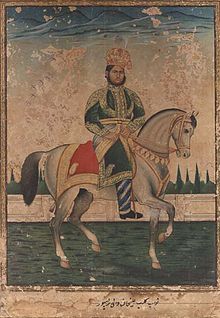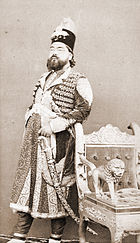
Back রামপুর রাজ্য Bengali/Bangla Rampur (estat) Catalan Rampur (Staat) German État de Rampur French रामपुर रियासत Hindi Rampur (stato) Italian ریاست رام پور PNB Рампур Russian Rampur State SIMPLE ராம்பூர் சமஸ்தானம் Tamil
State of Rampur Dar-Ul-Insha دارالانشا | |||||||||||||
|---|---|---|---|---|---|---|---|---|---|---|---|---|---|
| 1774–1947 | |||||||||||||
| Motto: "الحكم لله والملك لله" "Al Hukumu Lillah Wāl Mulk Lillah" .Lā Fata ʾIllā ʿAlī; Lā Sayf ʾIllā Ḏū l-Fiqār. | |||||||||||||
 Rampur State in yellow | |||||||||||||
| Status | 15 gun-salute princely state | ||||||||||||
| Capital | Rampur | ||||||||||||
| Official languages | |||||||||||||
| Other languages | |||||||||||||
| Religion |
| ||||||||||||
| Demonym(s) | Rampuri | ||||||||||||
| Government | Absolute monarchy | ||||||||||||
| Nawab | |||||||||||||
• 1774–1794 | Faizullah Khan (First) | ||||||||||||
• 1794 | Muhammad Ali Khan | ||||||||||||
• 1794 | Ghulam Muhammad Khan | ||||||||||||
• 1794–1840 | Ahmad Ali Khan | ||||||||||||
• 1930–1947/1966 | Raza Ali Khan (Last) | ||||||||||||
| History | |||||||||||||
| 7 October, 1774 | |||||||||||||
| 15 August, 1947 | |||||||||||||
| Area | |||||||||||||
• Total | 2,447.54 km2 (945.00 sq mi) (1st; princely state) | ||||||||||||
• Water (%) | 1 | ||||||||||||
| Population | |||||||||||||
• Estimate | 546,151 | ||||||||||||
• Census | 1901 | ||||||||||||
| Time zone | UTC+5:30 | ||||||||||||
| Driving side | left lane | ||||||||||||
| |||||||||||||
| Today part of | Uttar Pradesh, India | ||||||||||||




Rampur State was a 15 gun-salute princely state of British India. It came into existence on 7 October 1774 as a result of a treaty with Oudh. Following independence in 1947, Rampur State and other princely states of the area, such as Benares and Tehri Garhwal were merged into the United Provinces.[citation needed] Rampur state had its capital in Rampur city and its total area was 945 sq miles.[1] Rampur state was founded by Ali Mohammad Khan's younger son Faizullah Khan.[2][3][4][5]
The Jama Masjid is one of the finest piece of architecture to be found in Rampur. It resembles the Jama Masjid in Delhi to some extent.[original research?] It was built by Nawab Faizullah Khan. It has a unique Mughal touch to it. There are several entry-exit gates to the masjid. It has three big domes and four tall minarets with gold pinnacles boasting of a royal touch. It has a main lofty entrance gate that has an inbuilt clock tower occupied by a big clock that was imported from Britain.
There are several entry-exit gates built by the Nawab. These gates are major entry-exit routes from the city. Examples are Shahabad Gate, Nawab Gate, Bilaspur Gate etc.
- ^ Hunter, William Wilson (1881). The imperial gazetteer of India. India: Trübner & Company. pp. 544–546. Retrieved 16 December 2013.
Rampur state.
- ^ Wade, Bonnie C. (1984). Khyal: Creativity Within North India's Classical Music Tradition. CUP Archive. ISBN 978-0-521-25659-9.
- ^ The Indian Year Book. Bennett, Coleman & Company. 1945.
- ^ The Indian and Pakistan Year Book. Bennett, Coleman & Company. 1929.
- ^ Ashraf, Mujeeb (1982). Muslim Attitudes Towards British Rule and Western Culture in India in the First Half of the Nineteenth Century. Idarah-i Adabiyat-i Delli.

